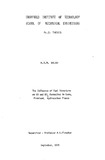JavaScript is disabled for your browser. Some features of this site may not work without it.
| dc.contributor.advisor | Fletcher, R. S. | |
| dc.contributor.author | Saleh, H. S. M. | |
| dc.date.accessioned | 2009-09-19T10:02:07Z | |
| dc.date.available | 2009-09-19T10:02:07Z | |
| dc.date.issued | 1978-09 | |
| dc.identifier.uri | http://hdl.handle.net/1826/3675 | |
| dc.description.abstract | A study is made of the influence chemical structure of fuel has upon combustion performance through tracing the generation of carbon monoxide and oxides of nitrogen in lean, premixed, hydrocarbon-air flames. The study includes both analytical and experimental investi- gations. On the analytical side, a kinetic model is developed to predict both CO and NO time-histories in one-dimensional, premixed flames. The model is based upon the assumption of partial equilibrium in the post-flame zone while the fuel oxidation in the main reaction zone is allowed for by using a global oxidation rate equation. NO formation is assumed to be entirely via the Zeldovitch mechanism and to start in the post-flame zone. The utility of the model is judged through comparison between theoretical results and experimental data. On the experimental side, a simple burner system, supporting a one-dimensional premixed flame was designed and built. All fuels selected for investigation were pure hydrocarbons representing the main hydrocarbon types usually found in practical fuels; namely paraffins, olefins, naphthenes and aromatics. The hydrogen-to-carbon ratio ranged from 1 to 2.67 and the carbon number from 3 to 12. The experiments were performed at 1,2 and 3 atm pressure levels and 140°C inlet temperature, while the equivalence ratio was in the range 0.6 to 0.9. Flames were sampled for most stable species by a water- cooled stainless steel sampling probe. The experimental results show that the fuel structure signifi- cantly affects CO time-histories in the investigated flames mainly through influencing its generation rather than its burnout. CO burnout is shown to be mainly controlled by radical recombination processes, and the experimentally derived CO global oxidation rate equations are found not to be universally applicable. The results also show that the fuel structure influences prompt NOx formation within, and very near, the main reaction zone but that it does not influence post-equilibrium NOx formation if account is taken of differences in the flame temperatures. N02 is found to constitute a large percentage of total NOx measured especially at lower temperature and equivalence ratios. Comparison between experimental and theoretical results show that the prescribed kinetic model can satisfactorily predict CO levels for different fuels and under different conditions if the fuel oxidation global rate equation is correctly defined for different fuels. On the other hand, agreement between predicted and measured NO profiles has been obtained at atmospheric pressure only. At high pressure, the predicted levels were much smaller than those measured experimentally, and this disagreement is attributed to the fact that proper account is not taken of the NO and N02 formation kinetics in the main reaction zone. | en_UK |
| dc.language.iso | en | en_UK |
| dc.publisher | Cranfield University | en_UK |
| dc.title | The influence of fuel structure on CO and NOx formation in lean premixed hydrocarbon flames | en_UK |
| dc.type | Thesis or dissertation | en_UK |
| dc.type.qualificationlevel | Doctoral | en_UK |
| dc.type.qualificationname | PhD | en_UK |
